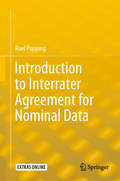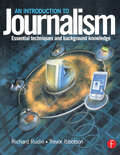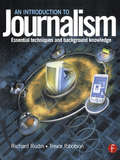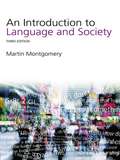- Table View
- List View
An Introduction to Interaction: Understanding Talk in the Workplace and Everyday Life
by Angela Cora GarciaAn engaging introduction to the study of spoken interaction, this book provides a thorough grounding in the theory and methodology of conversation analysis. It covers data collection, techniques for analysis and practical applications, and guides students through foundational and new research findings on everyday conversations and talk in institutional contexts, from media, business, and education to healthcare and law. Now thoroughly updated to showcase contemporary developments in the field, this second edition includes: · New chapters on interaction in psychotherapy, educational settings and language learning and teaching · Expanded coverage of doctor-patient communications, customer service and business meetings workplace interviews and online interactions, including social media, video gaming and livestreams · A wider variety of research on other languages, including French, German, Italian, Finnish, Swedish, Arabic, Korean, Chinese and Japanese · Multimodal analyses of interaction, focusing on the integration of embodied action and talk Complete with student activities, recommended reading sections and a companion website featuring slides, quiz questions, and links to further transcripts, this book is an essential guide for doing conversation analysis and offers fresh insight into how we understand talk.
An Introduction to Interaction: Understanding Talk in the Workplace and Everyday Life
by Angela Cora GarciaAn engaging introduction to the study of spoken interaction, this book provides a thorough grounding in the theory and methodology of conversation analysis. It covers data collection, techniques for analysis and practical applications, and guides students through foundational and new research findings on everyday conversations and talk in institutional contexts, from media, business, and education to healthcare and law. Now thoroughly updated to showcase contemporary developments in the field, this second edition includes: · New chapters on interaction in psychotherapy, educational settings and language learning and teaching · Expanded coverage of doctor-patient communications, customer service and business meetings workplace interviews and online interactions, including social media, video gaming and livestreams · A wider variety of research on other languages, including French, German, Italian, Finnish, Swedish, Arabic, Korean, Chinese and Japanese · Multimodal analyses of interaction, focusing on the integration of embodied action and talk Complete with student activities, recommended reading sections and a companion website featuring slides, quiz questions, and links to further transcripts, this book is an essential guide for doing conversation analysis and offers fresh insight into how we understand talk.
An Introduction to International Varieties of English (Edinburgh Textbooks on the English Language)
by Laurie BauerThis book looks at native speaker varieties of English, considering how and why they differ in terms of their pronunciation, grammar, vocabulary and spelling.
An Introduction to International Varieties of English (Edinburgh Textbooks on the English Language)
by Laurie BauerThis book looks at native speaker varieties of English, considering how and why they differ in terms of their pronunciation, grammar, vocabulary and spelling.
Introduction to Interrater Agreement for Nominal Data (SpringerBriefs in Statistics)
by Roel PoppingThis introductory book enables researchers and students of all backgrounds to compute interrater agreements for nominal data. It presents an overview of available indices, requirements, and steps to be taken in a research project with regard to reliability, preceded by agreement. The book explains the importance of computing the interrater agreement and how to calculate the corresponding indices. Furthermore, it discusses current views on chance expected agreement and problems related to different research situations, so as to help the reader consider what must be taken into account in order to achieve a proper use of the indices.The book offers a practical guide for researchers, Ph.D. and master students, including those without any previous training in statistics (such as in sociology, psychology or medicine), as well as policymakers who have to make decisions based on research outcomes in which these types of indices are used.
Introduction to Journalism
by Carole Fleming Dave Welford Emma Hemmingway Gillian Moore'The book does what it says on the label. It is punctuated throughout with useful and relevant quotes from working journalists - their opinions, tips and warnings - a technique that drives home the message and adds life and colour' -THES Textbook Guide The job of a journalist has changed dramatically over the past few decades with satellite links, 24 hour rolling news, and the Internet creating constant pressure for the latest updates. But for all that, the fundamentals of doing the job remain the same: it's about identifying a story, getting the interviews, and delivering a balanced and interesting report. 'Introduction to Journalism' examines the skills needed to work as a journalist in newspapers, television, radio and online: " Provides case studies as a guide to researching stories, interviewing, and writing for each medium, as well as recording material for both radio and television. " Offers a wide range of comment and tips on the best way to approach stories " Includes interviews with journalists working on a variety of news outlets from the BBC to weekly newspapers. This book provides a lively and authoritative introduction to journalism and readers will enjoy the insight from a range of journalists.
Introduction to Journalism: Essential techniques and background knowledge
by Richard Rudin Trevor IbbotsonAnyone studying journalism, or training for the industry, will benefit from the broad scope of information and guidance packed into this textbook. Those already employed in journalism or related areas will also find it useful as a reference book. Essential techniques employed by journalists working across all media are supplemented with detailed sections on the workings of public administration, law, health and safety, regulation and training. Each chapter concludes with suggested learning activities and an extensive list of resources for further study and investigation. The approach throughout chapters covering background issues (e.g. law) is 'journalism centred': all topics are related to the interests and concerns of journalists and journalism. Students of the City and Guilds Diploma in Media Techniques will find the book particularly relevant to their studies as it has been developed to reflect the syllabus of this course.
Introduction to Journalism: Essential techniques and background knowledge
by Richard Rudin Trevor IbbotsonAnyone studying journalism, or training for the industry, will benefit from the broad scope of information and guidance packed into this textbook. Those already employed in journalism or related areas will also find it useful as a reference book. Essential techniques employed by journalists working across all media are supplemented with detailed sections on the workings of public administration, law, health and safety, regulation and training. Each chapter concludes with suggested learning activities and an extensive list of resources for further study and investigation. The approach throughout chapters covering background issues (e.g. law) is 'journalism centred': all topics are related to the interests and concerns of journalists and journalism. Students of the City and Guilds Diploma in Media Techniques will find the book particularly relevant to their studies as it has been developed to reflect the syllabus of this course.
Introduction to Journalism (PDF)
by Carole Fleming Dave Welford Emma Hemmingway Gillian Moore'The book does what it says on the label. It is punctuated throughout with useful and relevant quotes from working journalists - their opinions, tips and warnings - a technique that drives home the message and adds life and colour' -THES Textbook Guide The job of a journalist has changed dramatically over the past few decades with satellite links, 24 hour rolling news, and the Internet creating constant pressure for the latest updates. But for all that, the fundamentals of doing the job remain the same: it's about identifying a story, getting the interviews, and delivering a balanced and interesting report. 'Introduction to Journalism' examines the skills needed to work as a journalist in newspapers, television, radio and online: " Provides case studies as a guide to researching stories, interviewing, and writing for each medium, as well as recording material for both radio and television. " Offers a wide range of comment and tips on the best way to approach stories " Includes interviews with journalists working on a variety of news outlets from the BBC to weekly newspapers. This book provides a lively and authoritative introduction to journalism and readers will enjoy the insight from a range of journalists.
An Introduction to Language (Linguistics in the World)
by Kirk HazenAn Introduction to Language offers an engaging guide to the nature of language, focusing on how language works – its sounds, words, structures, and phrases – all investigated through wide-ranging examples from Old English to contemporary pop culture. Explores the idea of a scientific approach to language, inviting students to consider what qualities of language comprise everyday skills for us, be they sounds, words, phrases, or conversation Helps shape our understanding of what language is, how it works, and why it is both elegantly complex and essential to who we are Includes exercises within each chapter to help readers explore key concepts and directly observe the patterns that are part of all human language Examines linguistic variation and change to illustrate social nuances and language-in-use, drawing primarily on examples from English Avoids linguistic jargon, focusing instead on a broader and more general approach to the study of language, and making it ideal for those coming to the subject for the first time Supported by additional web resources – available upon publication at www.wiley.com/go/hazen/introlanguage – including student study aids and testbank and notes for instructors
An Introduction to Language (Linguistics in the World)
by Kirk HazenAn Introduction to Language offers an engaging guide to the nature of language, focusing on how language works – its sounds, words, structures, and phrases – all investigated through wide-ranging examples from Old English to contemporary pop culture. Explores the idea of a scientific approach to language, inviting students to consider what qualities of language comprise everyday skills for us, be they sounds, words, phrases, or conversation Helps shape our understanding of what language is, how it works, and why it is both elegantly complex and essential to who we are Includes exercises within each chapter to help readers explore key concepts and directly observe the patterns that are part of all human language Examines linguistic variation and change to illustrate social nuances and language-in-use, drawing primarily on examples from English Avoids linguistic jargon, focusing instead on a broader and more general approach to the study of language, and making it ideal for those coming to the subject for the first time Supported by additional web resources – available upon publication at www.wiley.com/go/hazen/introlanguage – including student study aids and testbank and notes for instructors
An Introduction to Language and Communication for Allied Health and Social Care Professions
by Simone C. BacchiniBringing insights from linguistics to those without a background in this field, An Introduction to Language and Communication for Allied Health and Social Care Professions enables readers to better appreciate the ways in which language functions simultaneously as an instrument to encode and communicate meaning, build and sustain interpersonal relationships, and express identity. Grounded in the understanding of language as a multifunctional, interactional tool offered by sociolinguistics, pragmatics, and discourse analysis, the book: Provides readers with well-grounded tools that they can use to inform their daily work as well as to reflect upon their own communicative practices and – where necessary – to improve them Features ‘discussion points’ in the form of questions, suggestions for reflection, and small analysis tasks throughout Contains end-of-chapter summaries and suggestions for further reading An Introduction to Language and Communication for Allied Health and Social Care Professions is ideal as a core or supplementary textbook for students on degrees in public health, social work, social care, nursing, and other allied health professions who are taking courses in communication. It is also an invaluable guide for qualified health and social care practitioners, to support both their professional practice and their continuing professional development.
An Introduction to Language and Communication for Allied Health and Social Care Professions
by Simone C. BacchiniBringing insights from linguistics to those without a background in this field, An Introduction to Language and Communication for Allied Health and Social Care Professions enables readers to better appreciate the ways in which language functions simultaneously as an instrument to encode and communicate meaning, build and sustain interpersonal relationships, and express identity. Grounded in the understanding of language as a multifunctional, interactional tool offered by sociolinguistics, pragmatics, and discourse analysis, the book: Provides readers with well-grounded tools that they can use to inform their daily work as well as to reflect upon their own communicative practices and – where necessary – to improve them Features ‘discussion points’ in the form of questions, suggestions for reflection, and small analysis tasks throughout Contains end-of-chapter summaries and suggestions for further reading An Introduction to Language and Communication for Allied Health and Social Care Professions is ideal as a core or supplementary textbook for students on degrees in public health, social work, social care, nursing, and other allied health professions who are taking courses in communication. It is also an invaluable guide for qualified health and social care practitioners, to support both their professional practice and their continuing professional development.
An Introduction to Language and Linguistics: Breaking the Language Spell
by Christopher J. Hall'Christopher Hall's book is the best new introduction to linguistics that I have seen in decades. It is engagingly written without talking down to the reader and it covers all the subparts of the field in a comprehensive and even-handed manner. I plan to use it the next time that I teach an introductory course at Washington.' Professor Frederick J. Newmeyer, University of Washington 'With apt examples from novels and newspapers, courtroom trials and telephone conversations, the lowly and the mighty, his book repeatedly startles as it casts light on language. This is a bright, humorous, and completely accessible tour of 21st-century linguistics.' Professor Edward Finegan, University of Southern California This book introduces the fundamentals of human language from a linguistic point of view, using examples drawn from everyday life to aid comprehension, and encouraging critical thinking throughout. Besides presenting the fundamental building blocks of language and explaining how these function, the book also introduces other key elements of the discipline of linguistics, including language acquisition, applied linguistics, psycholinguistics and discourse analysis. Packed full of examples, this is the ideal introduction to language for those who are interested in studying linguistics, have already started a course, or just want to study at home.
An Introduction to Language and Social Justice: What Is, What Has Been, and What Could Be
by Netta Avineri Patricia Baquedano-LópezThis innovative, interdisciplinary course textbook is designed to provide the who, what, where, when, why, and how of the intersections of language, inequality, and social justice in North America, using the applied linguistic anthropology (ALA) framework. Written in accessible language and at a level equally legible for advanced undergraduate and graduate students, this text connects theory and practice by sketching out relevant historical background, introducing theoretical and conceptual underpinnings, illustrating with case studies, discussing a wide range of key issues, and explaining research methodologies. Using a general-to-specialized content structure, the expert authors then show readers how to apply these principles and lessons in communities in the real world, to become advocates and change agents in the realm of language and social justice. With an array of useful pedagogical resources and practical tools including discussion questions and activities, reflections and vignettes, further reading and a glossary, along with additional online resources for instructors, this is the essential text for students from multiple perspectives across linguistics, applied linguistics, linguistic anthropology, and beyond.
An Introduction to Language and Social Justice: What Is, What Has Been, and What Could Be
by Netta Avineri Patricia Baquedano-LópezThis innovative, interdisciplinary course textbook is designed to provide the who, what, where, when, why, and how of the intersections of language, inequality, and social justice in North America, using the applied linguistic anthropology (ALA) framework. Written in accessible language and at a level equally legible for advanced undergraduate and graduate students, this text connects theory and practice by sketching out relevant historical background, introducing theoretical and conceptual underpinnings, illustrating with case studies, discussing a wide range of key issues, and explaining research methodologies. Using a general-to-specialized content structure, the expert authors then show readers how to apply these principles and lessons in communities in the real world, to become advocates and change agents in the realm of language and social justice. With an array of useful pedagogical resources and practical tools including discussion questions and activities, reflections and vignettes, further reading and a glossary, along with additional online resources for instructors, this is the essential text for students from multiple perspectives across linguistics, applied linguistics, linguistic anthropology, and beyond.
An Introduction to Language and Society
by Martin MontgomeryIn this third edition of the bestselling classic textbook, Martin Montgomery explores the key connections between language and social life. Guiding the student through discussions on child language, accent and dialect, social class and gender, as well as a number of other topics, Montgomery provides a comprehensive and accessible introduction to the function of language in modern society. This third edition includes: new sections on dialect levelling and estuary English; hip-hop and rapping as anti-language and ‘crossing’ between Creole, Panjabi and South Asian English new material on the Gulf War and the 'War on Terror' discussions on language in internet usage and new technologies updated examples and references. With detailed suggestions for further reading and practical work for each chapter, An Introduction to Language and Society is the ideal resource for students and teachers of Communication Studies and Language Studies.
An Introduction to Language and Society
by Martin MontgomeryIn this third edition of the bestselling classic textbook, Martin Montgomery explores the key connections between language and social life. Guiding the student through discussions on child language, accent and dialect, social class and gender, as well as a number of other topics, Montgomery provides a comprehensive and accessible introduction to the function of language in modern society. This third edition includes: new sections on dialect levelling and estuary English; hip-hop and rapping as anti-language and ‘crossing’ between Creole, Panjabi and South Asian English new material on the Gulf War and the 'War on Terror' discussions on language in internet usage and new technologies updated examples and references. With detailed suggestions for further reading and practical work for each chapter, An Introduction to Language and Society is the ideal resource for students and teachers of Communication Studies and Language Studies.
Introduction to Language Pathology
by David Crystal Rosemary VarleyThis new edition includes the introduction of the WHO distinctions between impairment, disability and handicap; an increased focus on information processing approaches to language disorders, and the introduction of revision questions as well as tutorial activities at the end of every chapter to support student learning.
Introduction to Language Pathology
by David Crystal Rosemary VarleyThis new edition includes the introduction of the WHO distinctions between impairment, disability and handicap; an increased focus on information processing approaches to language disorders, and the introduction of revision questions as well as tutorial activities at the end of every chapter to support student learning.
An Introduction to Language Policy: Theory and Method (Language and Social Change)
by Thomas RicentoAn Introduction to Language Policy: Theories and Method is a collection of newly-written chapters that cover the major theories and methods currently employed by scholars active in the field. provides an accessible introduction to the study of language policy research and language’s role in social life consists of newly commissioned essays written by internationally recognized scholars helps define and describe a growing field of inquiry and is an authoritative source for students, scholars and researchers in linguistics, applied linguistics, education, policy studies and related areas includes section overviews, annotated chapter bibliographies, and discussion questions
An Introduction to Language Processing with Perl and Prolog: An Outline of Theories, Implementation, and Application with Special Consideration of English, French, and German (Cognitive Technologies)
by Pierre M. NuguesThis book teaches the principles of natural language processing and covers linguistics issues. It also details the language-processing functions involved, including part-of-speech tagging using rules and stochastic techniques. A key feature of the book is the author's hands-on approach throughout, with extensive exercises, sample code in Prolog and Perl, and a detailed introduction to Prolog. The book is suitable for researchers and students of natural language processing and computational linguistics.
An Introduction to Lexical Semantics: A Formal Approach to Word Meaning and its Composition
by EunHee LeeAn Introduction to Lexical Semantics provides a comprehensive theoretical overview of lexical semantics, analysing the major lexical categories in English: verbs, nouns, adjectives, adverbs and prepositions. The book illustrates step-by-step how to use formal semantic tools. Divided into four parts, covering the key aspects of lexical semantics, this book: introduces readers to the major influential theories including the syntax-lexical semantics interface theory by Levin and Rappaport and Pinker, the generative lexicon theory by Pustejovsky and formal semantic analyses discusses key topics in formal semantics including metonymy, metaphor and polysemy illustrates how to study word meaning scientifically by discussing mathematical notions applied to compositional semantics. Including reflection questions, summaries, further reading and practice exercises for each chapter, this accessible guide to lexical semantics is essential reading for advanced students and teachers of formal semantics.
An Introduction to Lexical Semantics: A Formal Approach to Word Meaning and its Composition
by EunHee LeeAn Introduction to Lexical Semantics provides a comprehensive theoretical overview of lexical semantics, analysing the major lexical categories in English: verbs, nouns, adjectives, adverbs and prepositions. The book illustrates step-by-step how to use formal semantic tools. Divided into four parts, covering the key aspects of lexical semantics, this book: introduces readers to the major influential theories including the syntax-lexical semantics interface theory by Levin and Rappaport and Pinker, the generative lexicon theory by Pustejovsky and formal semantic analyses discusses key topics in formal semantics including metonymy, metaphor and polysemy illustrates how to study word meaning scientifically by discussing mathematical notions applied to compositional semantics. Including reflection questions, summaries, further reading and practice exercises for each chapter, this accessible guide to lexical semantics is essential reading for advanced students and teachers of formal semantics.
Introduction to Linguistic Annotation and Text Analytics (Synthesis Lectures on Human Language Technologies)
by Graham WilcockLinguistic annotation and text analytics are active areas of research and development, with academic conferences and industry events such as the Linguistic Annotation Workshops and the annual Text Analytics Summits. This book provides a basic introduction to both fields, and aims to show that good linguistic annotations are the essential foundation for good text analytics. After briefly reviewing the basics of XML, with practical exercises illustrating in-line and stand-off annotations, a chapter is devoted to explaining the different levels of linguistic annotations. The reader is encouraged to create example annotations using the WordFreak linguistic annotation tool. The next chapter shows how annotations can be created automatically using statistical NLP tools, and compares two sets of tools, the OpenNLP and Stanford NLP tools. The second half of the book describes different annotation formats and gives practical examples of how to interchange annotations between different formats using XSLT transformations. The two main text analytics architectures, GATE and UIMA, are then described and compared, with practical exercises showing how to configure and customize them. The final chapter is an introduction to text analytics, describing the main applications and functions including named entity recognition, coreference resolution and information extraction, with practical examples using both open source and commercial tools. Copies of the example files, scripts, and stylesheets used in the book are available from the companion website, located at the book website. Table of Contents: Working with XML / Linguistic Annotation / Using Statistical NLP Tools / Annotation Interchange / Annotation Architectures / Text Analytics
















